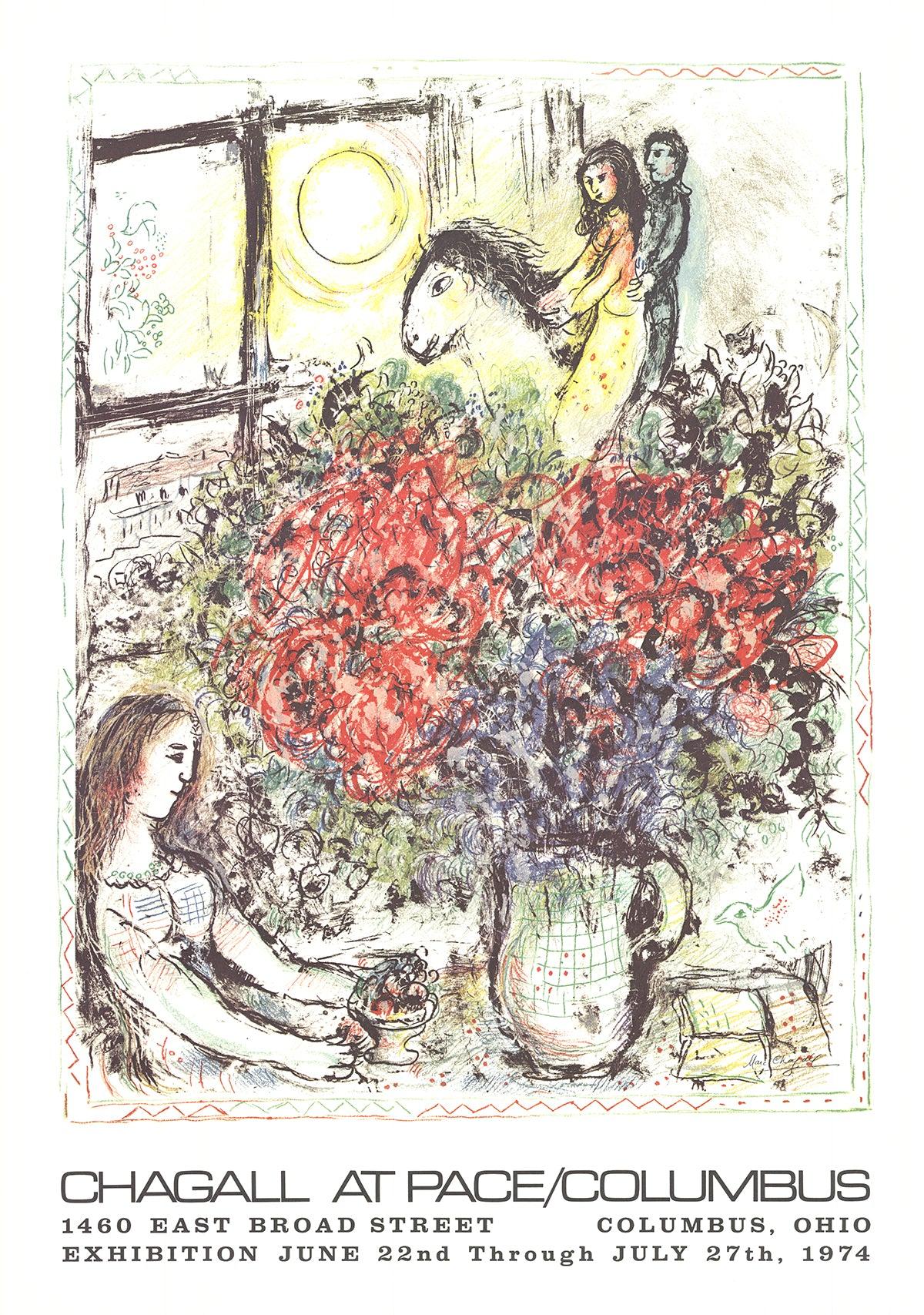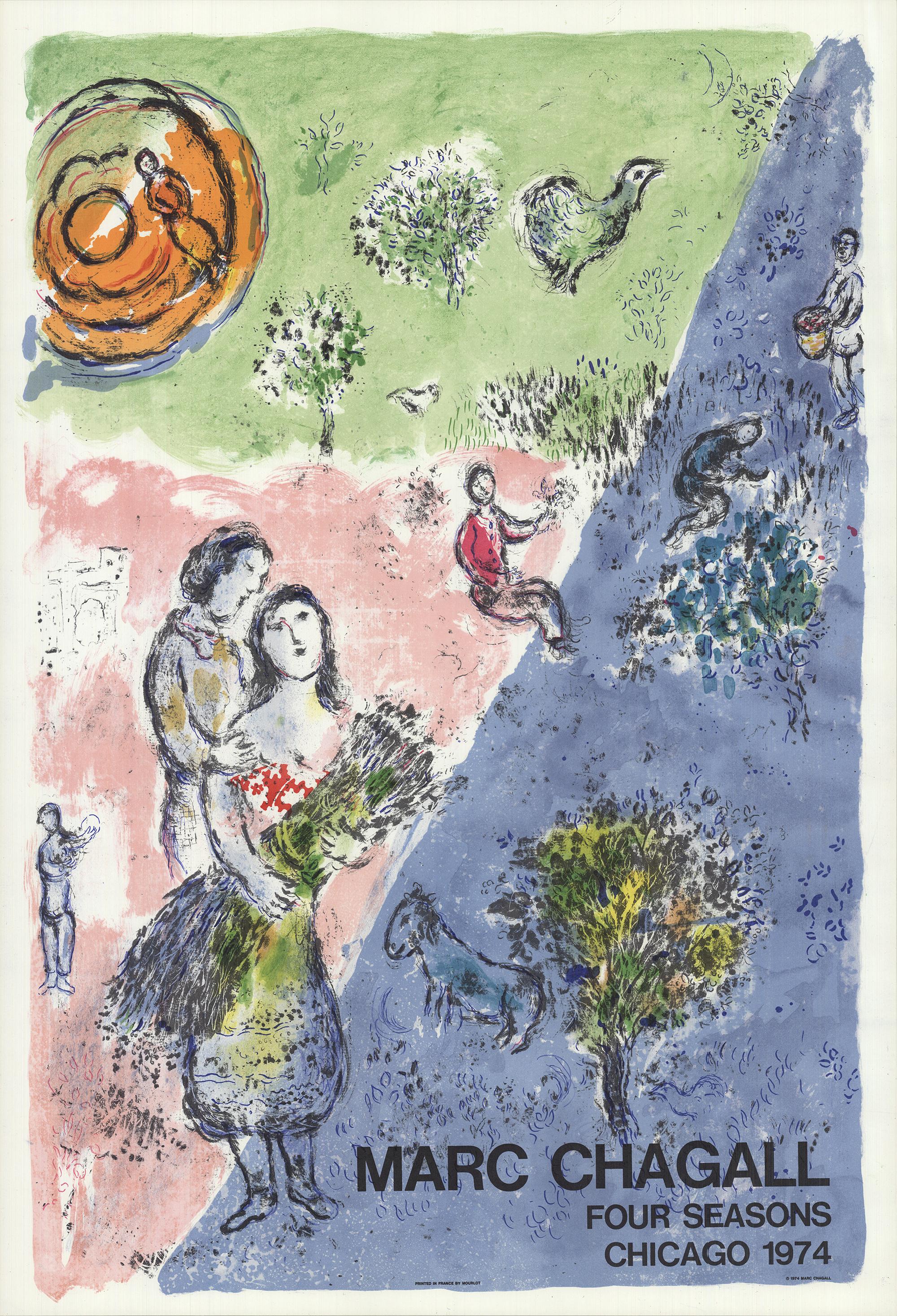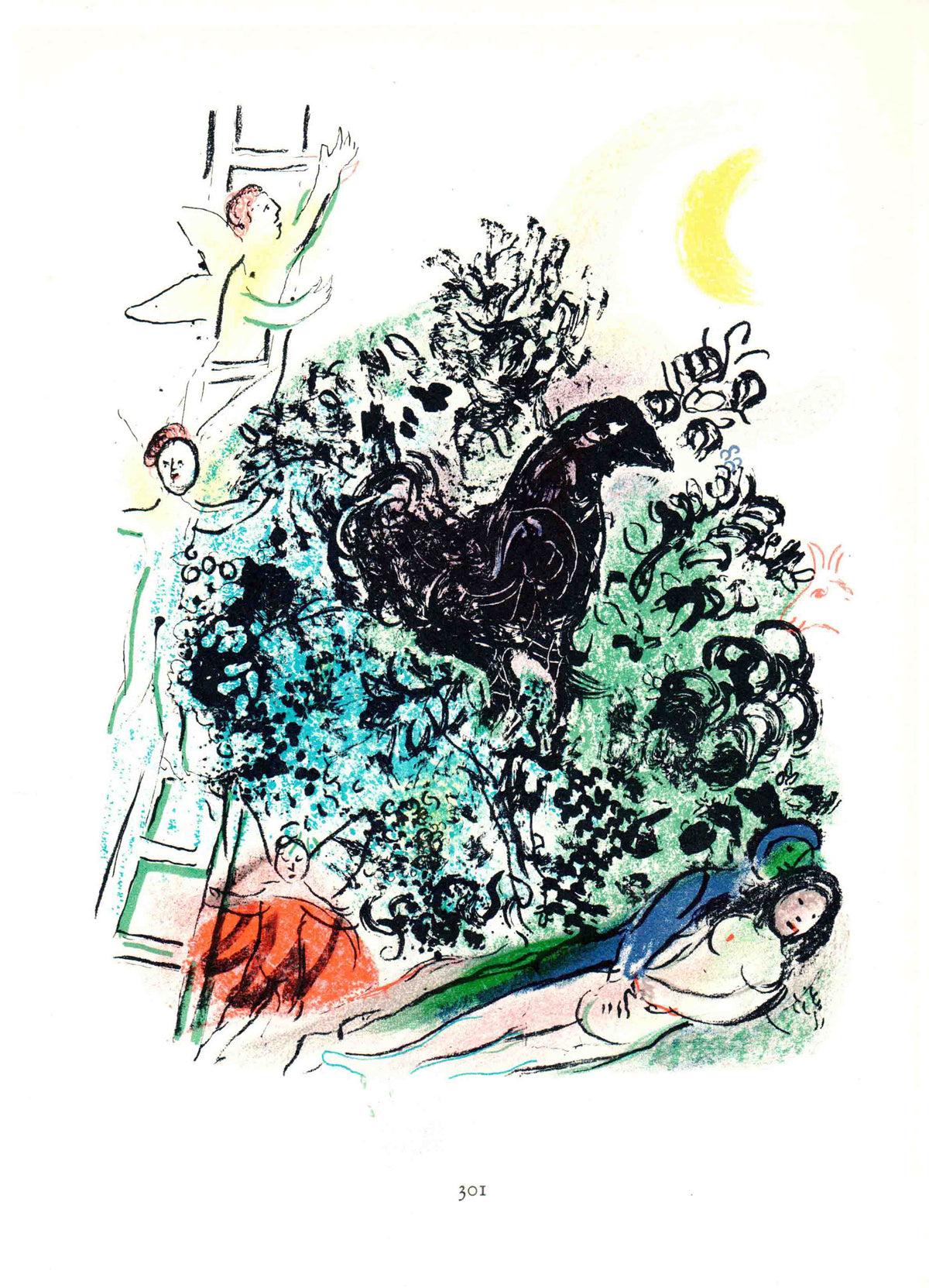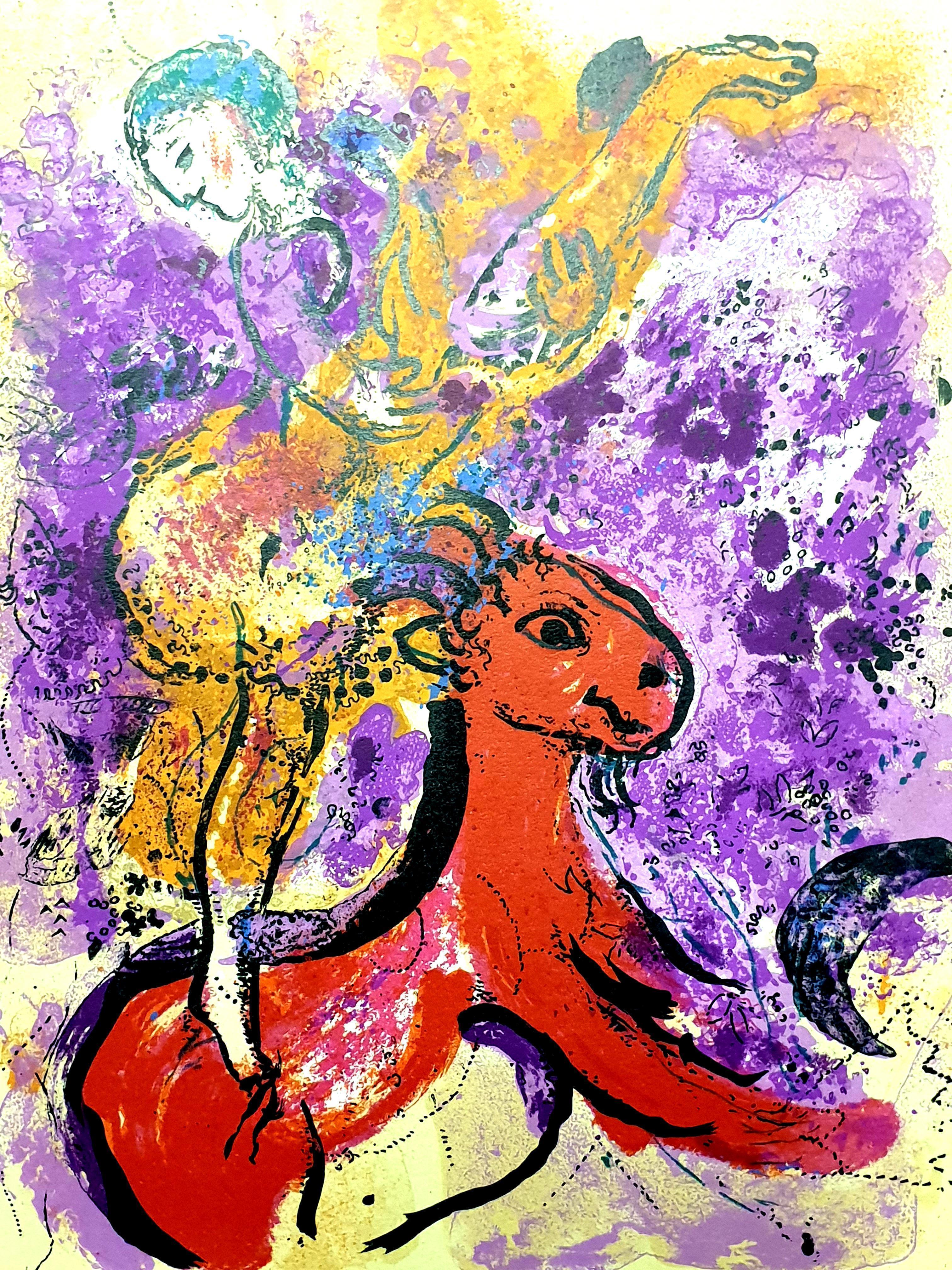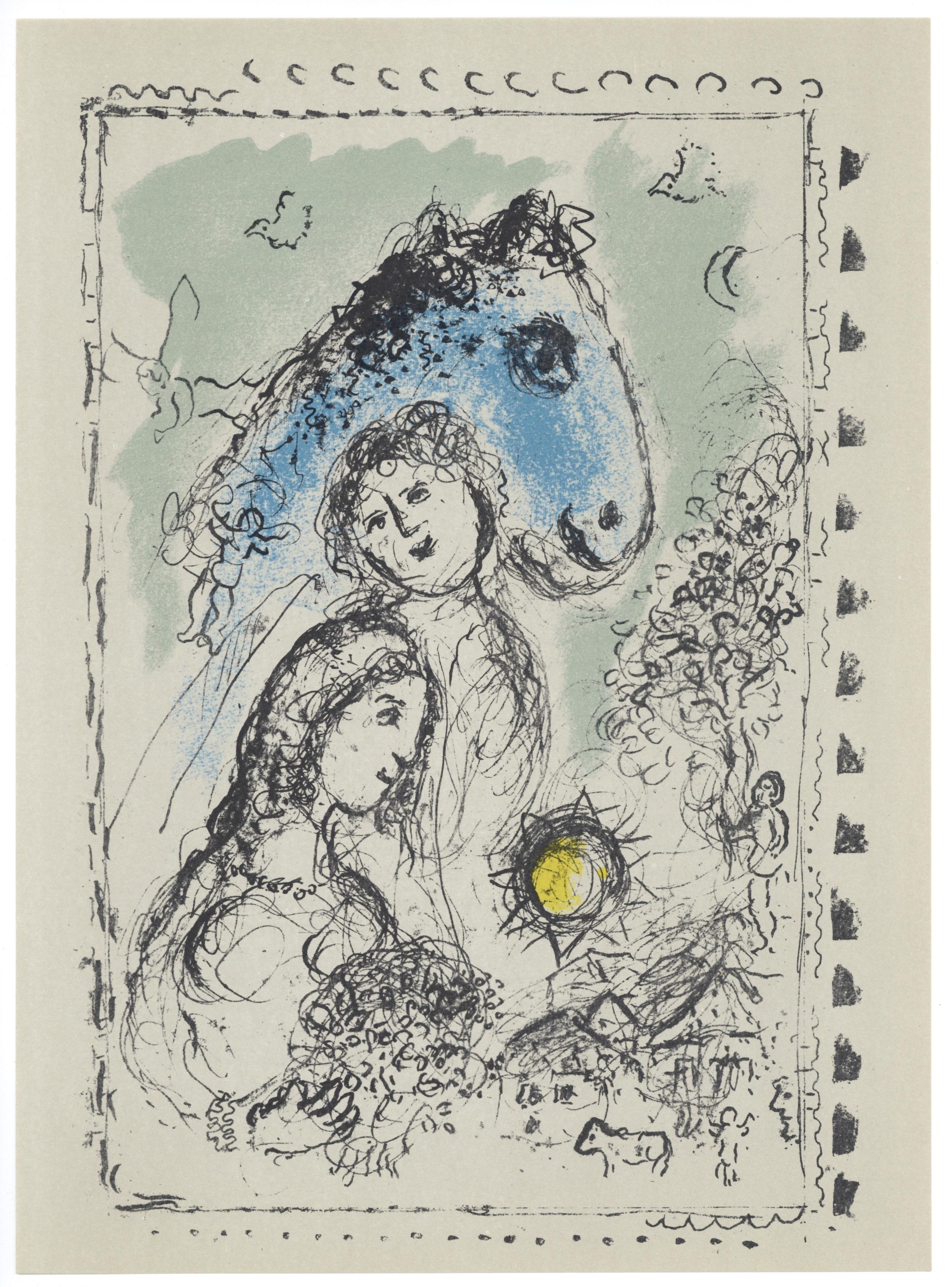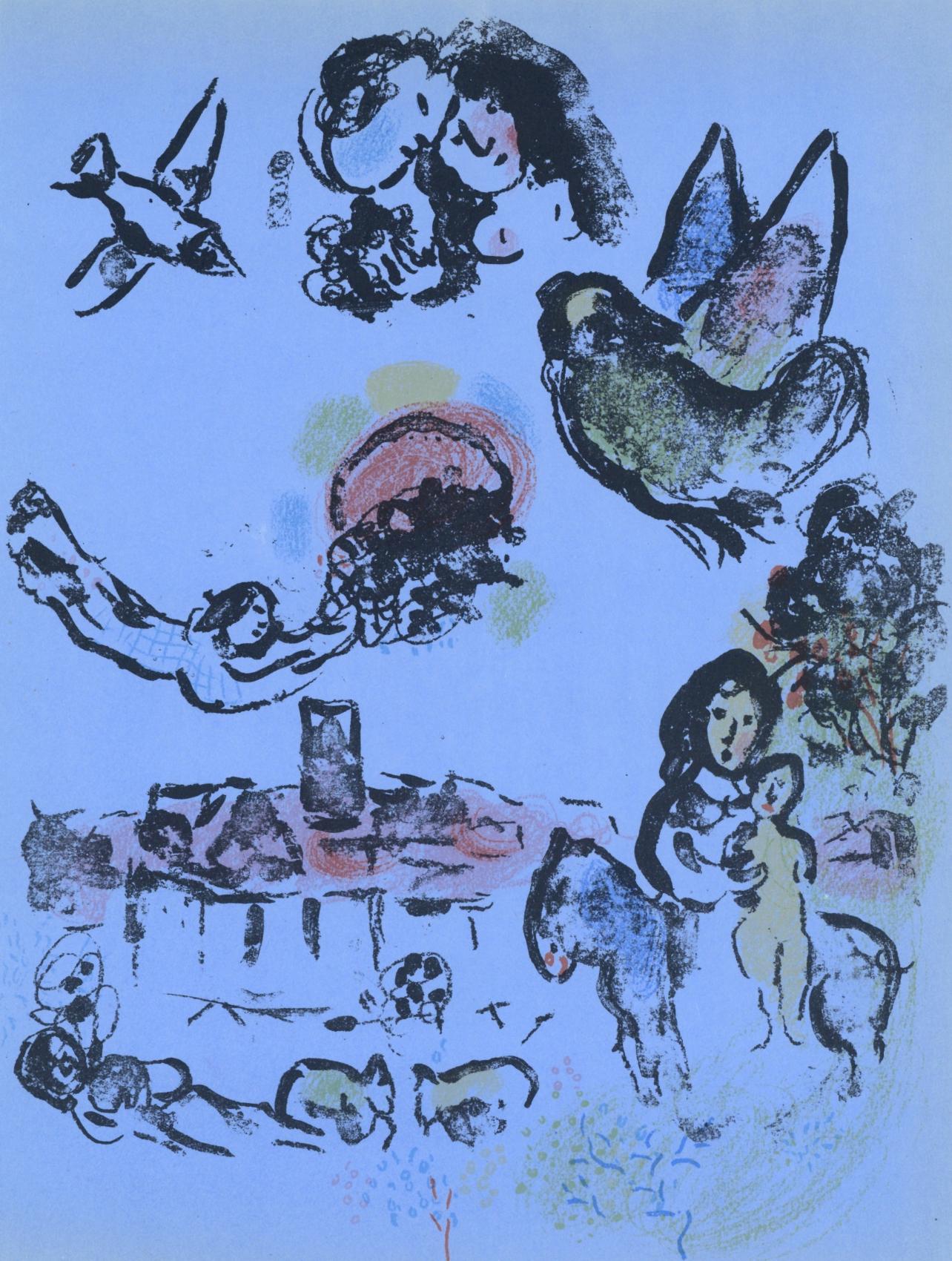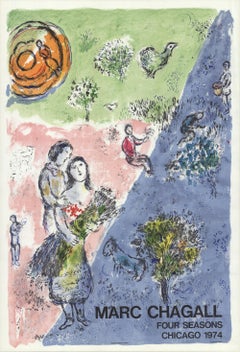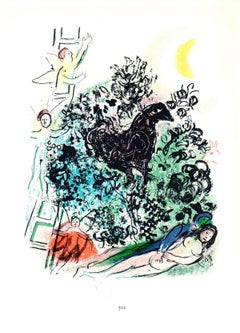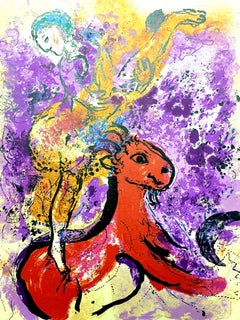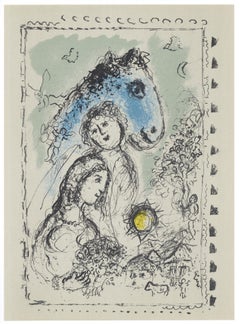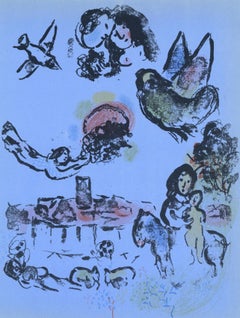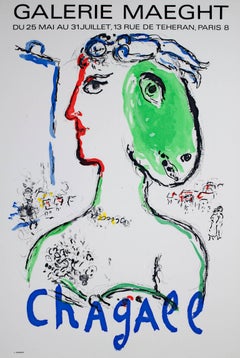Items Similar to Marc Chagall 'La Chevauchee (The Ride)' 1979 Vintage, Poster
Want more images or videos?
Request additional images or videos from the seller
1 of 5
Marc Chagall 'La Chevauchee (The Ride)' 1979 Vintage, Poster1979
1979
$150
£115.57
€132.02
CA$214.75
A$234.23
CHF 123.16
MX$2,810.86
NOK 1,554.97
SEK 1,450.37
DKK 985.98
About the Item
This limited edition print by Marc Chagall, titled "La Chevauchée" (The Horse Ride), was created for an exhibition held at Pace Columbus in 1979. The print is signed in the plate, meaning Chagall's signature is part of the original composition, rather than hand-signed. It showcases Chagall's characteristic blend of whimsy and surrealism, with dynamic movement, rich colors, and fantastical imagery.
Published by Pace Columbus, this piece exemplifies Chagall’s ability to combine vibrant elements of folklore and personal symbolism, often focusing on themes of freedom, nature, and love. The exhibition poster, as well as the print, remain valuable for collectors of Chagall’s later works.
Paper Size: 27.25 x 22 inches ( 69 x 56 cm )
Image Size: 24.5 x 19 inches ( 62 x 48 cm )
Framing available, request a quote
Condition: A: Mint
Shipping and Handling: We ship Worldwide. For Domestic and International shipments alike, we use heavy, thick-walled UPS and FedEx Approved shipping tubes to ship all items that are rollable. For items that cannot be rolled, we pack the item flat.
Attention International Buyers, Please Note: Import duties, taxes, and charges are not included in the item price or shipping cost. These charges are the buyer's responsibility. Please check with your country's customs office to determine what these additional costs will be prior to bidding or buying.
- Creation Year:1979
- Dimensions:Height: 27.25 in (69.22 cm)Width: 22 in (55.88 cm)Depth: 0.1 in (2.54 mm)
- Medium:
- Movement & Style:
- After:Marc Chagall (1887 - 1985, French)
- Period:
- Framing:Framing Options Available
- Condition:All items are carefully stored. Condition is a main concern, unless otherwise indicated, all items are in mint condition. Additional pictures are available upon request. Feel free to contact our team if you have any questions or concerns. Thank you.
- Gallery Location:Brooklyn, NY
- Reference Number:Seller: AW11131stDibs: LU1294117034322
About the Seller
4.9
Platinum Seller
Premium sellers with a 4.7+ rating and 24-hour response times
Established in 1992
1stDibs seller since 2019
2,723 sales on 1stDibs
Typical response time: 1 hour
- ShippingRetrieving quote...Shipping from: Brooklyn, NY
- Return Policy
More From This Seller
View AllMarc Chagall 'La Chevauchee' 1979- Lithograph Vintage
By Marc Chagall
Located in Brooklyn, NY
This limited edition print by Marc Chagall, titled La Chevauchée (The Horse Ride), was published by Pace Columbus for an exhibition held at the gallery in 1979. The print is signed i...
Category
1970s Modern Prints and Multiples
Materials
Lithograph
Marc Chagall Exhibition Poster, The Four Seasons- STONE LITHOGRAPH Vintage
By (after) Marc Chagall
Located in Brooklyn, NY
This 1974 poster, printed by Mourlot and published by The First National Bank of Chicago, was created to commemorate the unveiling of Marc Chagall’s large mosaic at the Four Seasons...
Category
1970s Modern Prints and Multiples
Materials
Lithograph
Marc Chagall 'Songe d'un Amoureux' 1963, Vintage
By Marc Chagall
Located in Brooklyn, NY
Book page 117 in Chagall Lithographe II (1957-1962). Reproduction of image from 1961.
‘Chagall Lithographe II' Andre Sauret, Paris, 1963. Text in French by Fernand Mourlot. The seco...
Category
1960s Prints and Multiples
Materials
Offset
$72 Sale Price
20% Off
Marc Chagall 'Le Piege' 1963, Vintage
By Marc Chagall
Located in Brooklyn, NY
Book page 179 in Chagall Lithographe II (1957-1962) Reproduction of lithograph created in 1962.
Book text in French by Fernand Mourlot. It is the second of five catalogues. This ed...
Category
1960s Prints and Multiples
Materials
Offset
$100 Sale Price
20% Off
Marc Chagall 'La Ruche' 1979 Lithograph, Mourlot, Vintage
By Marc Chagall
Located in Brooklyn, NY
This lithograph, titled La Ruche, was printed by Mourlot for Marc Chagall’s 1979 exhibition at the Musée Jacquemart-André in Paris. It portrays Chaga...
Category
1970s Modern Prints and Multiples
Materials
Lithograph
Marc Chagall, Good Morning Paris, 1972 LITHOGRAPH Vintage
By (after) Marc Chagall
Located in Brooklyn, NY
In Good Morning Paris (1972), Chagall uses deep, rich hues of blue and red to create a vivid scene. At the center, the Eiffel Tower rises prominently, framed by an early morning cres...
Category
1970s Modern Prints and Multiples
Materials
Lithograph
You May Also Like
Marc Chagall - The Red Rider - Original Lithograph
By Marc Chagall
Located in Collonge Bellerive, Geneve, CH
Marc Chagall - Original Lithograph
The Red Rider
From the unsigned, unnumbered lithograph printed in the literary review XXe Siecle
1957
See Mourlot 191
Dimensions: 32 x 24 cm
Publisher: G. di San Lazzaro.
Marc Chagall (born in 1887)
Marc Chagall was born in Belarus in 1887 and developed an early interest in art. After studying painting, in 1907 he left Russia for Paris, where he lived in an artist colony on the city’s outskirts. Fusing his own personal, dreamlike imagery with hints of the fauvism and cubism popular in France at the time, Chagall created his most lasting work—including I and the Village (1911)—some of which would be featured in the Salon des Indépendants exhibitions. After returning to Vitebsk for a visit in 1914, the outbreak of WWI trapped Chagall in Russia. He returned to France in 1923 but was forced to flee the country and Nazi persecution during WWII. Finding asylum in the U.S., Chagall became involved in set and costume design before returning to France in 1948. In his later years, he experimented with new art forms and was commissioned to produce numerous large-scale works. Chagall died in St.-Paul-de-Vence in 1985.
The Village
Marc Chagall was born in a small Hassidic community on the outskirts of Vitebsk, Belarus, on July 7, 1887. His father was a fishmonger, and his mother ran a small sundries shop in the village. As a child, Chagall attended the Jewish elementary school, where he studied Hebrew and the Bible, before later attending the Russian public school. He began to learn the fundamentals of drawing during this time, but perhaps more importantly, he absorbed the world around him, storing away the imagery and themes that would feature largely in most of his later work.
At age 19 Chagall enrolled at a private, all-Jewish art school and began his formal education in painting, studying briefly with portrait artist Yehuda Pen. However, he left the school after several months, moving to St. Petersburg in 1907 to study at the Imperial Society for the Protection of Fine Arts. The following year, he enrolled at the Svanseva School, studying with set designer Léon Bakst, whose work had been featured in Sergei Diaghilev's Ballets Russes. This early experience would prove important to Chagall’s later career as well.
Despite this formal instruction, and the widespread popularity of realism in Russia at the time, Chagall was already establishing his own personal style, which featured a more dreamlike unreality and the people, places and imagery that were close to his heart. Some examples from this period are his Window Vitebsk (1908) and My Fianceé with Black Gloves (1909), which pictured Bella Rosenfeld, to whom he had recently become engaged.
The Beehive
Despite his romance with Bella, in 1911 an allowance from Russian parliament member and art patron Maxim Binaver enabled Chagall to move to Paris, France. After settling briefly in the Montparnasse neighborhood, Chagall moved further afield to an artist colony known as La Ruche (“The Beehive”), where he began to work side by side with abstract painters such as Amedeo Modigliani and Fernand Léger as well as the avant-garde poet Guillaume Apollinaire. At their urging, and under the influence of the wildly popular fauvism and cubism, Chagall lightened his palette and pushed his style ever further from reality. I and the Village (1911) and Homage to Apollinaire (1912) are among his early Parisian works, widely considered to be his most successful and representative period.
Though his work stood stylistically apart from his cubist contemporaries, from 1912 to 1914 Chagall exhibited several paintings at the annual Salon des Indépendants exhibition, where works by the likes of Juan Gris, Marcel Duchamp and Robert Delaunay were causing a stir in the Paris art world. Chagall’s popularity began to spread beyond La Ruche, and in May 1914 he traveled to Berlin to help organize his first solo exhibition, at Der Sturm Gallery. Chagall remained in the city until the highly acclaimed show opened that June. He then returned to Vitebsk, unaware of the fateful events to come.
War, Peace and Revolution
In August 1914 the outbreak of World War I precluded Chagall’s plans to return to Paris. The conflict did little to stem the flow of his creative output, however, instead merely giving him direct access to the childhood scenes so essential to his work, as seen in paintings such as Jew in Green (1914) and Over Vitebsk (1914). His paintings from this period also occasionally featured images of the war’s impact on the region, as with Wounded Soldier (1914) and Marching (1915). But despite the hardships of life during wartime, this would also prove to be a joyful period for Chagall. In July 1915 he married Bella, and she gave birth to a daughter, Ida, the following year. Their appearance in works such as Birthday (1915), Bella and Ida by the Window (1917) and several of his “Lovers” paintings give a glimpse of the island of domestic bliss that was Chagall’s amidst the chaos.
To avoid military service and stay with his new family, Chagall took a position as a clerk in the Ministry of War Economy in St. Petersburg. While there he began work on his autobiography and also immersed himself in the local art scene, befriending novelist Boris Pasternak, among others. He also exhibited his work in the city and soon gained considerable recognition. That notoriety would prove important in the aftermath of the 1917 Russian Revolution when he was appointed as the Commissar of Fine Arts in Vitebsk. In his new post, Chagall undertook various projects in the region, including the 1919 founding of the Academy of the Arts. Despite these endeavors, differences among his colleagues eventually disillusioned Chagall. In 1920 he relinquished his position and moved his family to Moscow, the post-revolution capital of Russia.
In Moscow, Chagall was soon commissioned to create sets and costumes for various productions at the Moscow State Yiddish Theater, where he would paint a series of murals titled Introduction to the Jewish Theater as well. In 1921, Chagall also found work as a teacher at a school for war orphans. By 1922, however, Chagall found that his art had fallen out of favor, and seeking new horizons he left Russia for good.
Flight
After a brief stay in Berlin, where he unsuccessfully sought to recover the work exhibited at Der Sturm before the war, Chagall moved his family to Paris in September 1923. Shortly after their arrival, he was commissioned by art dealer and publisher Ambroise Vollard to produce a series of etchings for a new edition of Nikolai Gogol's 1842 novel Dead Souls. Two years later Chagall began work on an illustrated edition of Jean de la Fontaine’s Fables, and in 1930 he created etchings for an illustrated edition of the Old Testament, for which he traveled to Palestine to conduct research.
Chagall’s work during this period brought him new success as an artist and enabled him to travel throughout Europe in the 1930s. He also published his autobiography, My Life (1931), and in 1933 received a retrospective at the Kunsthalle in Basel, Switzerland. But at the same time that Chagall’s popularity was spreading, so, too, was the threat of Fascism and Nazism. Singled out during the cultural "cleansing" undertaken by the Nazis in Germany, Chagall’s work was ordered removed from museums throughout the country. Several pieces were subsequently burned, and others were featured in a 1937 exhibition of “degenerate art” held in Munich. Chagall’s angst regarding these troubling events and the persecution of Jews in general can be seen in his 1938 painting White Crucifixion.
With the eruption of World War II, Chagall and his family moved to the Loire region before moving farther south to Marseilles following the invasion of France. They found a more certain refuge when, in 1941, Chagall’s name was added by the director of the Museum of Modern Art (MOMA) in New York City to a list of artists and intellectuals deemed most at risk from the Nazis’ anti-Jewish campaign. Chagall and his family would be among the more than 2,000 who received visas and escaped this way.
Haunted Harbors
Arriving in New York City in June 1941, Chagall discovered that he was already a well-known artist there and, despite a language barrier, soon became a part of the exiled European artist community. The following year he was commissioned by choreographer Léonide Massine to design sets and costumes for the ballet Aleko, based on Alexander Pushkin’s “The Gypsies” and set to the music of Pyotr Ilyich Tchaikovsky.
But even as he settled into the safety of his temporary home, Chagall’s thoughts were frequently consumed by the fate befalling the Jews of Europe and the destruction of Russia, as paintings such as The Yellow Crucifixion...
Category
1950s Surrealist Figurative Prints
Materials
Lithograph
original lithograph
By Marc Chagall
Located in Henderson, NV
Medium: original lithograph. Printed in 1982 for the art revue Derriere le Miroir (issue number 250, dedicated in homage to Aime and Marguerite Maeght) and published in Paris by the ...
Category
1980s Prints and Multiples
Materials
Lithograph
Marc Chagall, Nocturne in Vence, from The Lithographs of Chagall, 1963
By Marc Chagall
Located in Southampton, NY
This exquisite lithograph by Marc Chagall (1887–1985), titled Nocturne a Vence (Nocturne in Vence), from the album The Lithographs of Chagall, Volume II, originates from the 1963 edi...
Category
1960s Expressionist Figurative Prints
Materials
Lithograph
$956 Sale Price
20% Off
Free Shipping
L'Artist Phoenix Poster
By Marc Chagall
Located in Milwaukee, WI
Marc Chagall "L'Artist Phoenix Poster" for Galerie Maeght from 1972. It is from the edition of 5000.
30 1/2" x 20" art
40 1/2" x 32 1/4" frame
Marc Ch...
Category
1970s Expressionist More Prints
Materials
Lithograph
$2,800 Sale Price
20% Off
1970 lithograph by Marc Chagall for the French art review XXe Siècle
By Marc Chagall
Located in PARIS, FR
Playful, tender, and steeped in dreamlike emotion, this original 1970 lithograph by Marc Chagall was created as a contribution to the French art review XXe Siècle—an influential publ...
Category
1970s Prints and Multiples
Materials
Paper, Lithograph
"Maternite au Centaure" original lithograph
By Marc Chagall
Located in Henderson, NV
Medium: original lithograph. Catalogue reference: Mourlot 195. Printed in 1957 at the Mourlot atelier and published in Paris by Maeght. This charming composition is one of the origin...
Category
1950s Portrait Prints
Materials
Lithograph
